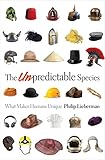The Unpredictable Species : What Makes Humans Unique / Philip Lieberman.
Material type: TextPublisher: Princeton, NJ : Princeton University Press, [2013]Copyright date: ©2013Edition: Course BookDescription: 1 online resource (272 p.) : 12 line illusContent type:
TextPublisher: Princeton, NJ : Princeton University Press, [2013]Copyright date: ©2013Edition: Course BookDescription: 1 online resource (272 p.) : 12 line illusContent type: - 9780691148588
- 9781400846702
- 612.8/2 23
- QP376 .L563 2013
- online - DeGruyter
- Issued also in print.
| Item type | Current library | Call number | URL | Status | Notes | Barcode | |
|---|---|---|---|---|---|---|---|
 eBook
eBook
|
Biblioteca "Angelicum" Pont. Univ. S.Tommaso d'Aquino Nuvola online | online - DeGruyter (Browse shelf(Opens below)) | Online access | Not for loan (Accesso limitato) | Accesso per gli utenti autorizzati / Access for authorized users | (dgr)9781400846702 |
Browsing Biblioteca "Angelicum" Pont. Univ. S.Tommaso d'Aquino shelves, Shelving location: Nuvola online Close shelf browser (Hides shelf browser)

|

|

|

|

|

|

|
||
| online - DeGruyter The Open Society and Its Enemies : New One-Volume Edition / | online - DeGruyter The Pity of Partition : Manto's Life, Times, and Work across the India-Pakistan Divide / | online - DeGruyter The Roots of Romanticism : Second Edition / | online - DeGruyter The Unpredictable Species : What Makes Humans Unique / | online - DeGruyter Tocqueville : The Aristocratic Sources of Liberty / | online - DeGruyter Waiting for José : The Minutemen's Pursuit of America / | online - DeGruyter War Powers : The Politics of Constitutional Authority / |
Frontmatter -- Contents -- Preface -- Acknowledgments -- Chapter One. Brainworks -- Chapter Two. Brain Design by Rube Goldberg -- Chapter Three. Darwin Got It Right -- Chapter Four. Chimpanzee Brain 2.0 -- Chapter Five. Stones, Bones, and Brains -- Chapter Six. The Gene Game -- Chapter Seven. What Makes Us Tick -- References -- Index
restricted access online access with authorization star
http://purl.org/coar/access_right/c_16ec
The Unpredictable Species argues that the human brain evolved in a way that enhances our cognitive flexibility and capacity for innovation and imitation. In doing so, the book challenges the central claim of evolutionary psychology that we are locked into predictable patterns of behavior that were fixed by genes, and refutes the claim that language is innate. Philip Lieberman builds his case with evidence from neuroscience, genetics, and physical anthropology, showing how our basal ganglia--structures deep within the brain whose origins predate the dinosaurs--came to play a key role in human creativity. He demonstrates how the transfer of information in these structures was enhanced by genetic mutation and evolution, giving rise to supercharged neural circuits linking activity in different parts of the brain. Human invention, expressed in different epochs and locales in the form of stone tools, digital computers, new art forms, complex civilizations--even the latest fashions--stems from these supercharged circuits. The Unpredictable Species boldly upends scientifically controversial yet popular beliefs about how our brains actually work. Along the way, this compelling book provides insights into a host of topics related to human cognition, including associative learning, epigenetics, the skills required to be a samurai, and the causes of cognitive confusion on Mount Everest and of Parkinson's disease.
Issued also in print.
Mode of access: Internet via World Wide Web.
In English.
Description based on online resource; title from PDF title page (publisher's Web site, viewed 30. Aug 2021)


